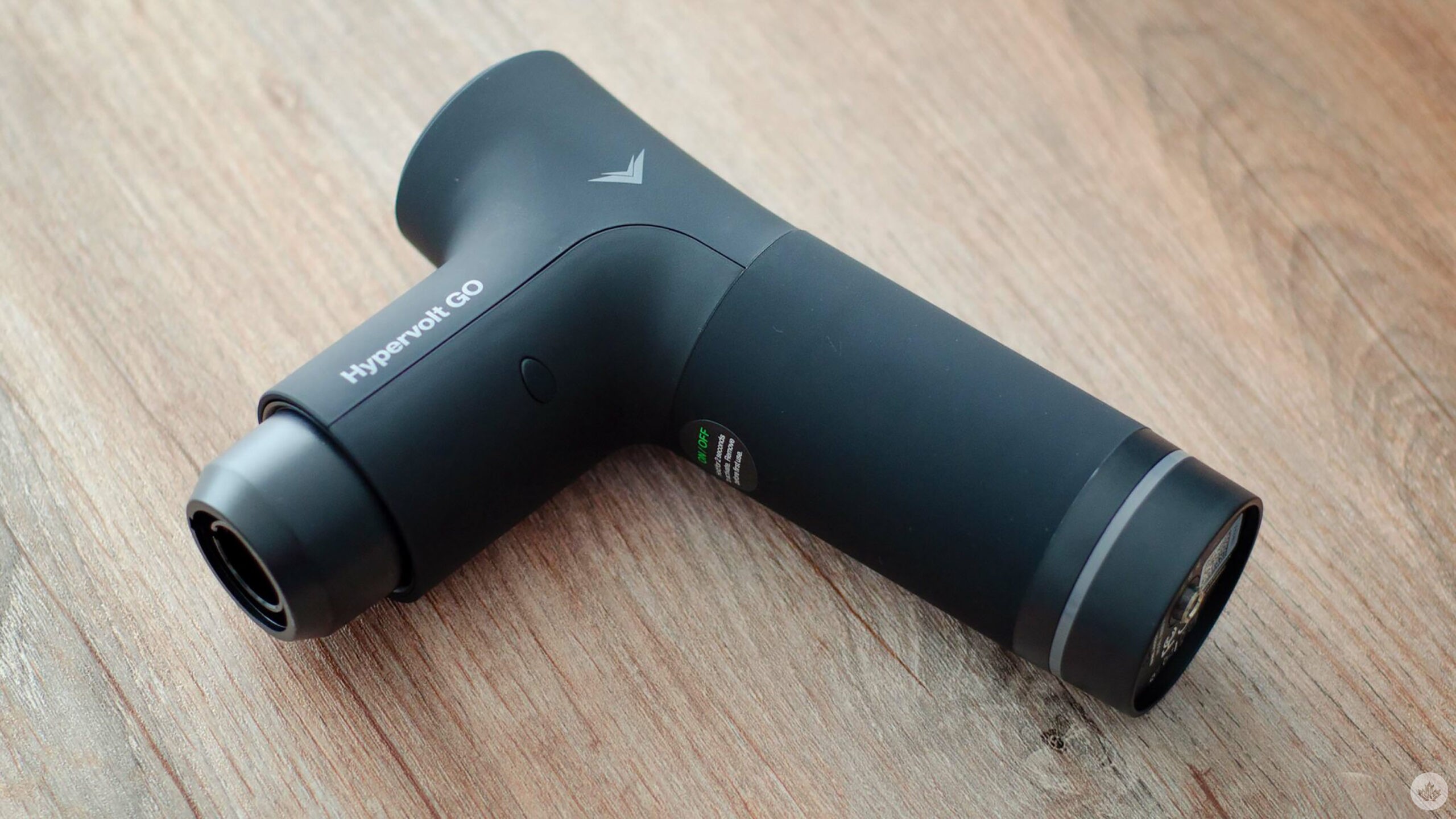
Every industry has its pointless “innovations” and new products that don’t live up to their hype, but the fitness world is especially rife with phoneys. For every truly useful product, like the torturous Rumble Roller, battle-tested TRX, or simple strength band, there are countless “as seen on TV” tools that promise big and deliver nil.
So it’s understandable that you’d be skeptical about the “percussive massager” trend that’s made the leap from physio clinics to gym bags. But speaking as one of those gym rats, I’ve been using a massage gun for more than a year to warm up worn-out muscles before workouts—and to jumpstart their recovery when I don’t warm up enough. And I’m absolutely sold on its benefits.
But with so many options and price points on the market, the trick is knowing which one to buy. Because as you’ll see, the most popular versions differ quite a bit in how they work—and in how you should use them.
First, a quick word on why a percussive massager deserves space in your gym bag (or on your coffee table). If you’ve ever visited a registered massage therapist—a proper one, not a day-spa masseur who pets you like a cat—you’ve felt that sweet, unbearable pain of knots being kneaded out. A massage gun won’t mimic that degree of expertise. Or the pain. But it will do a similar job of lengthening, releasing, and relaxing your muscles, either before or after a workout. It’s also a godsend when you’re feeling achy after a day of desk-sitting.
To help you make the right choice, we’ll start with popular models from Hyperice and Theragun, the two biggest (and most expensive) options on the market.
Hyperice Hypervolt Percussion Massager
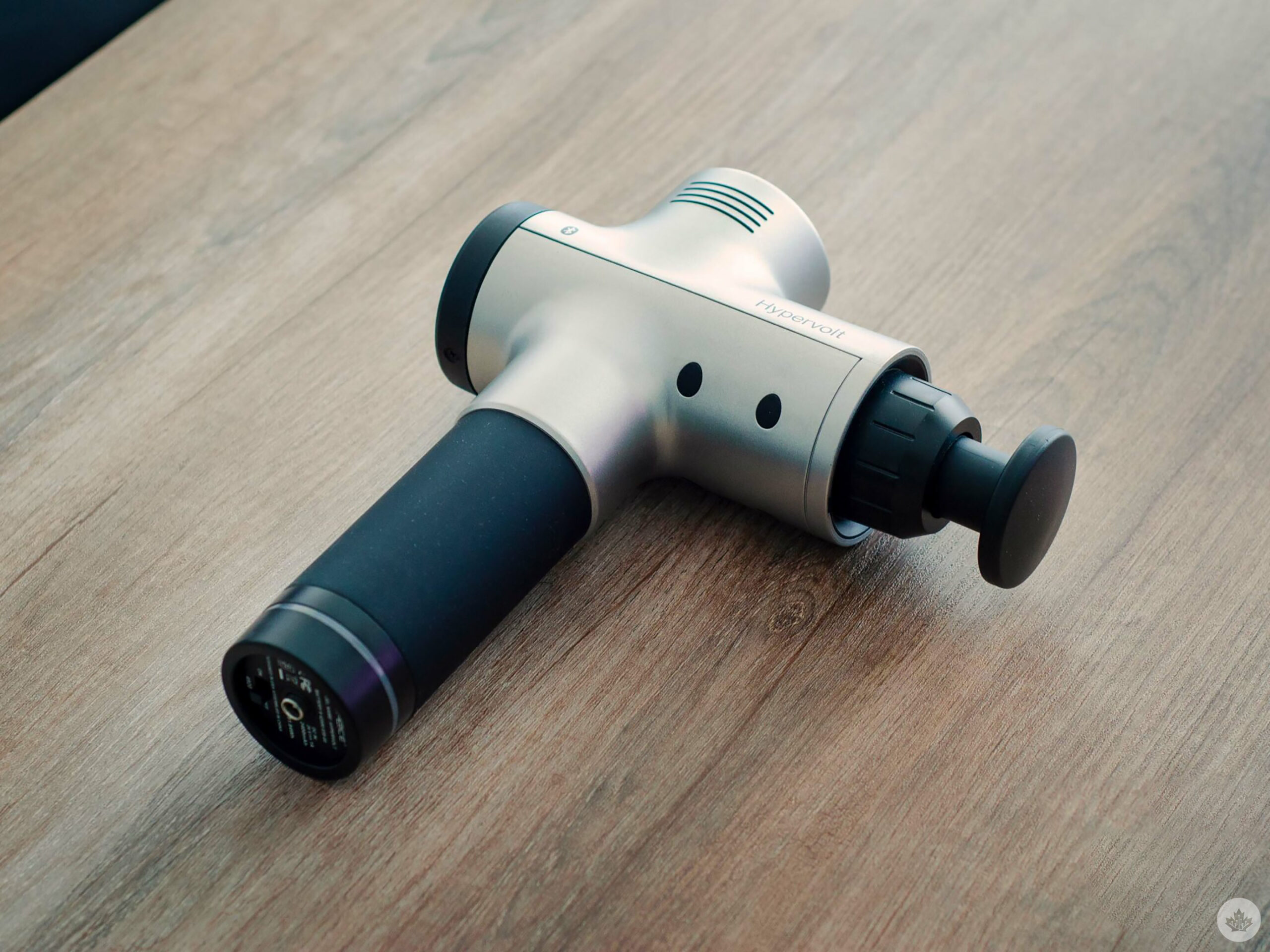 Unlike the Theragun, which is more “percussive,” the Hypervolt is more of a vibration-type massage gun. That means whichever of the five included heads travels a very short distance between your targeted muscle and the gun, but it does it at a very high speed—up to 3,200 percussions per minute, to be exact. The travel is still a lot more drastic than a typical vibration-based massager, but it’s much less of a hammer than the Theragun.
Unlike the Theragun, which is more “percussive,” the Hypervolt is more of a vibration-type massage gun. That means whichever of the five included heads travels a very short distance between your targeted muscle and the gun, but it does it at a very high speed—up to 3,200 percussions per minute, to be exact. The travel is still a lot more drastic than a typical vibration-based massager, but it’s much less of a hammer than the Theragun.
That doesn’t mean it’s worse; it just means it’s better suited for different applications. For instance, it’s ideal for relaxing tight muscles before a workout, and it’s equally adept at increasing blood flow and dispersing lactic-acid buildup after a tough training session.
Hypervolt pros
Like most of Hyperice’s vibrating products, the Hypervolt has a simple layout with three speeds. That may seem like too few, but it’s actually the perfect number. The jumps between them don’t feel severe, yet each setting is distinct enough to be useful.
But it’s when you arrive at the highest speed that the true benefit of the Hypervolt becomes apparent: it’s extremely quiet—especially after you’ve had experience with the brazenly loud Theragun. If your hip flexors are hurting and you just want some relief, the device’s volume might not seem important. But trust me—it matters. You might plan to keep the device in your gym bag and only use it at the gym, but you’ll probably end up using it most often on the couch while you watch Netflix. And this is one of the few massage guns that won’t drive your partner to turn on the captions if you use it beside them.
The ergonomics of the Hypervolt could be either a pro or a con, depending on your preference. A lot of people dislike the perpendicular handle, but I can’t imagine why. From my traps to my calves, I’ve never found it uncomfortable, and the way the handle extends above the gun in a lower-case “t” shape makes it easy to hold like a jackhammer and really dig in.
The Hyperice’s 1.12 kg weight is another love-hate proposition. Yes, it’s heavier than most other options. But again, I like that. Not only does the weight make it feel well made, but whenever it’s in use, you’re pressing it down towards your body. That means the weight is an advantage, just as it’s easier to drive in a nail with a heavier hammer.
One last plus: the battery life is top-drawer. The lithium-ion battery is billed to last three hours, but it seems like much longer. I use it daily, and I feel as though I charge it monthly. My indicator light is pure green right now (it fades to yellow and then red when it’s time to top up), and I can’t even remember the last time I plugged it in.
Hypervolt cons
Aside from the right-angle ergonomic and weight (both of which I actually prefer), it’s tough to find anything to grumble about with the Hypervolt. One constant gripe with users is that it doesn’t include a carrying case. So if that’s important to you, be warned. But there is a small case for the five interchangeable heads that it includes.
Those heads could be another sticking point. Most devices feature a foam or rubberized ball as their main fitting. And while the Hypervolt includes a ball, its main head is more of a hard pancake shape that took me a while to warm up to. The heads in general also feel like more of a hard, slippery plastic than those included with other devices, so they aren’t as “grippy” when you’re digging into a muscle. No doubt they’ll be durable, though.
Who should buy it?
The Hypervolt is one of the more expensive massage guns on the market, but it’s absolutely worth the investment if you train with any amount of intensity. It’s best suited to anyone looking to hasten their warmups and amplify their recovery—not armchair physiotherapists aiming to do anything deeply corrective.
Hypervolt Go
If you’re considering the Hypervolt, the smaller Hypervolt Go has likely caught your eye. It’s billed as a lighter, more portable version of the original, and at just 1.5 pounds, it’s extremely light, and its slightly askew handle does away with the “right angle” woes that some had with the original Hypervolt.
Handle and weight aside, the only differences between the Go and the flagship Hypervolt are the fact that it comes with only two heads (the “pancake” mentioned above and a more pointed appendage for digging into precise areas), and its battery is slated to last only 2.5 hours, which is still plenty. It also has a stall force of 15 lb., so pressing super hard will cause the motor to stall. That’s compared to 35 lb. of pressure for the full-scale Hypervolt, which has never stalled on me no matter how hard I press.
Theragun Prime Handheld Percussive Massage Device
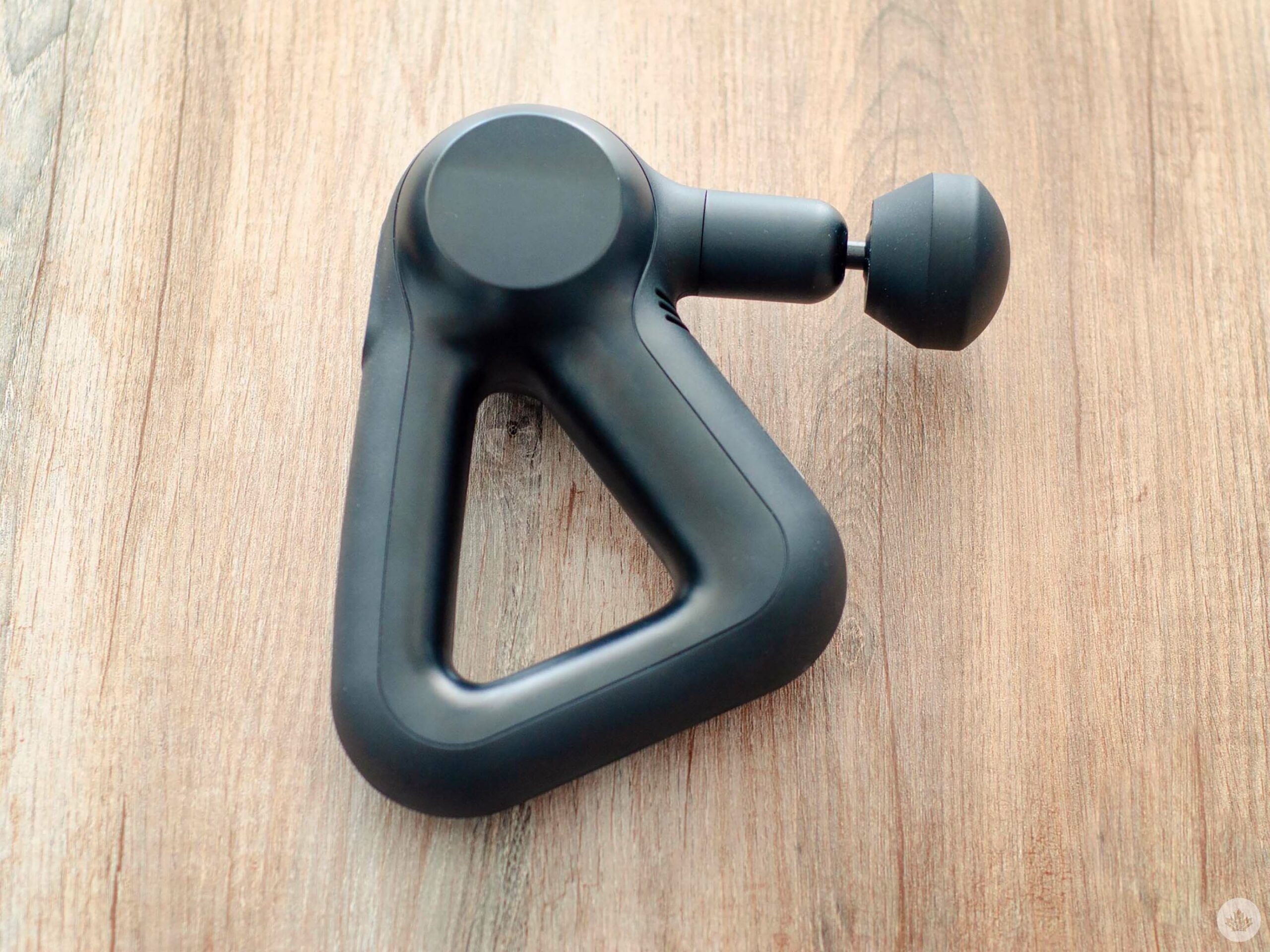 The Theragun Prime is the rowdier, rougher sibling of the Hypervolt, and the best word to describe it is “aggressive.” Whereas the Hypervolt is vibration-based, the Theragun is percussive. That means the undulating head travels a lot farther—16mm compared to the Hypervolt’s 10mm, and it roughs up your aching muscles like an unpaid bookie with a short temper.
The Theragun Prime is the rowdier, rougher sibling of the Hypervolt, and the best word to describe it is “aggressive.” Whereas the Hypervolt is vibration-based, the Theragun is percussive. That means the undulating head travels a lot farther—16mm compared to the Hypervolt’s 10mm, and it roughs up your aching muscles like an unpaid bookie with a short temper.
All of that aggression lends itself more to serious myofascial release and targeted range-of-motion correction, especially in larger muscle groups like your quads, hamstrings, glutes, and pecs. It’s downright intrusive. That’s probably why you’re more likely to see it in a physio clinic than on a coffee table. But what it doesn’t do is provide the more soothing, massage-like experience of the Hypervolt.
Theragun pros
There’s a lot to like in the Theragun package. And at its premium price point, that’s to be expected. Let’s start with two touted areas where the device really shines: power and ergonomics.
If you were to purchase the Hypervolt without ever trying another device, you’d probably never question its power. But when you try the Theragun immediately after using the Hypervolt, there’s a stark difference in how much it digs into your muscles. It’s like comparing a Prius to a Camaro. That’s maybe not a selling point for smaller muscle groups and light massage work. But if you’re trying to alleviate tight quads, hamstrings, or other major muscle groups, the Theragun hurts in the best possible way.
But even before you fire up the device, its curious ergonomics catch your eye. Its triangular handle offers multiple grips, and each of them is coated in a high-quality rubber that prevents the device from rattling the nerves in your palm. Personally, I like the Hypervolt’s L-shape handle better. I find that each of the Theragun’s three hand positions feels just a bit “off,” but that’s probably just because I’ve been using the Hypervolt a lot longer.
The Theragun doesn’t come with a case, but the box includes a thick microfibre bag that does just fine. It also includes four heads that range from “flattish and round” to a “dunce cap” point for targeting painful nooks and crannies. But the reason I like the heads isn’t their shapes (which are frankly much more useful than the Hypervolt’s) — it’s their material. Neither foam nor hard plastic, the heads are a durable, rubberized closed-cell foam with just the right amount of give, and they grip your skin without ever pinching or sticking in place. They’re honestly the best-feeling heads of any massage gun I’ve tested.
The device also features five usable speeds, each spaced far enough apart that they don’t feel like overkill. Plus, it’s a touch lighter than the Hypervolt while feeling just as well-made.
Theragun cons
Let’s address the very noisy elephant in the room. Wait, that’s not an elephant—it’s the Theragun’s rattly, rumbly motor drowning out your bookshelf speakers. All right, it’s not that bad. And yes, Theragun has made improvements to the volume of its flagship model. But it’s still pretty damn loud. After a session with the Theragun, the Hypervolt’s highest setting sounds like the purr of a sleeping cat. The Theragun, on the other hand, has an anxious, high-pitched mechanical rattle, and when you dig into a muscle, the device actually sounds like it’s whimpering in pain. But for many, the therapeutic benefits of its powerful motor will overshadow its grounds-for-divorce volume level.
Who should buy the Theragun?
I’d say buy it if you’re a physiotherapist, but you probably already own one. If you’re just a regular fitness buff trying to soothe aches and pains, it’s a highly worthwhile device—if you know how to use it properly. Just don’t go too hard on smaller muscle groups. And you might want to find a quieter device if you have roommates and thin walls.
Theragun Mini
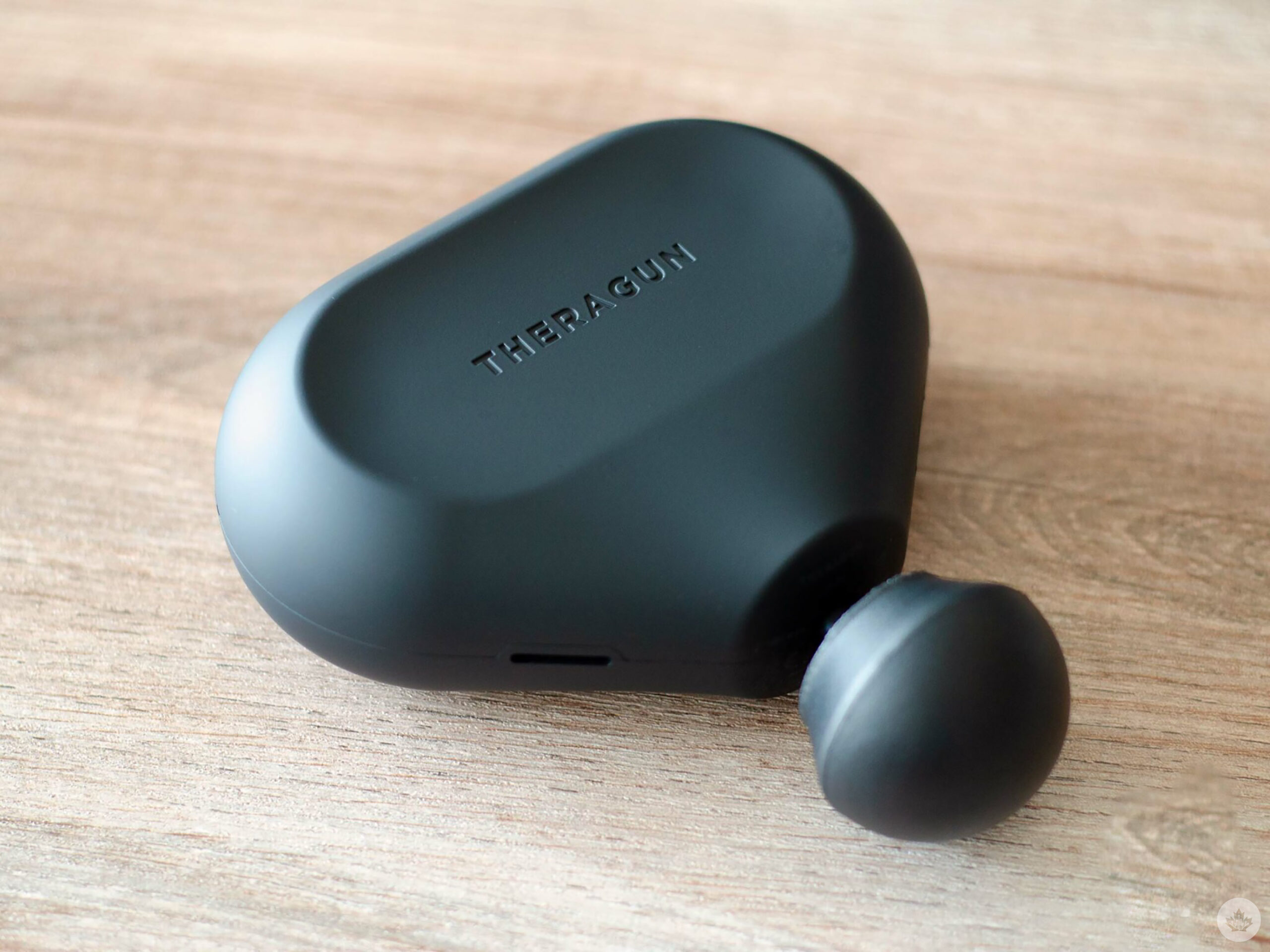 Just as the Hypervolt has the smaller Hypervolt Go, the Theragun has its own cheaper “Mini Me,” the Theragun Mini. And just like its bigger sibling, the Mini stands out with its odd but surprisingly ergonomic shape. Instead of the Theragun’s slightly awkward (but much-praised) triangular handle, the Mini is shaped like a thick rubber guitar pick. It might look weird, but it feels fantastic in the hand.
Just as the Hypervolt has the smaller Hypervolt Go, the Theragun has its own cheaper “Mini Me,” the Theragun Mini. And just like its bigger sibling, the Mini stands out with its odd but surprisingly ergonomic shape. Instead of the Theragun’s slightly awkward (but much-praised) triangular handle, the Mini is shaped like a thick rubber guitar pick. It might look weird, but it feels fantastic in the hand.
The Mini also does away with all but one of the heads: the basic round one, which is made of the same closed-cell foam. And frankly, that’s the only head most people will need, so the others are no great loss. The Mini does, however, one-up the flagship Theragun by including a case—though the case doesn’t include room for its charger.
In use, the Theragun Mini is a simplistic joy. Its strange handle feels great in almost every position, and there were very few body parts (mainly just my traps) where it didn’t actually feel preferable to its gun-like counterparts. It has enough heft to feel well-made without being exhausting to hold, and the large, rubberized grip area makes it easy to dig into tight muscles.
The Mini is slightly quieter than the larger Theragun, which is a blessing, but it still has a jagged rattle compared to a lot of its competitors. And though it has slightly less power and less amplitude (the head travels 12mm as opposed to 16mm), you likely won’t notice a major difference. Its 2.5 hours of battery life also make charging the device a once-per-week affair.
So is the Theragun Mini the right choice for you? If you want the perfect combination of power and portability, and you don’t mind the premium price, it’s absolutely the way to go. It’s highly useful, sufficiently powerful, and quiet(er), and it fits easily into a gym bag or carry-on without weighing you down. If you don’t mind jettisoning a few features, it’s pretty close to perfect.
The Best of the Rest
EZ-X Premium Massager
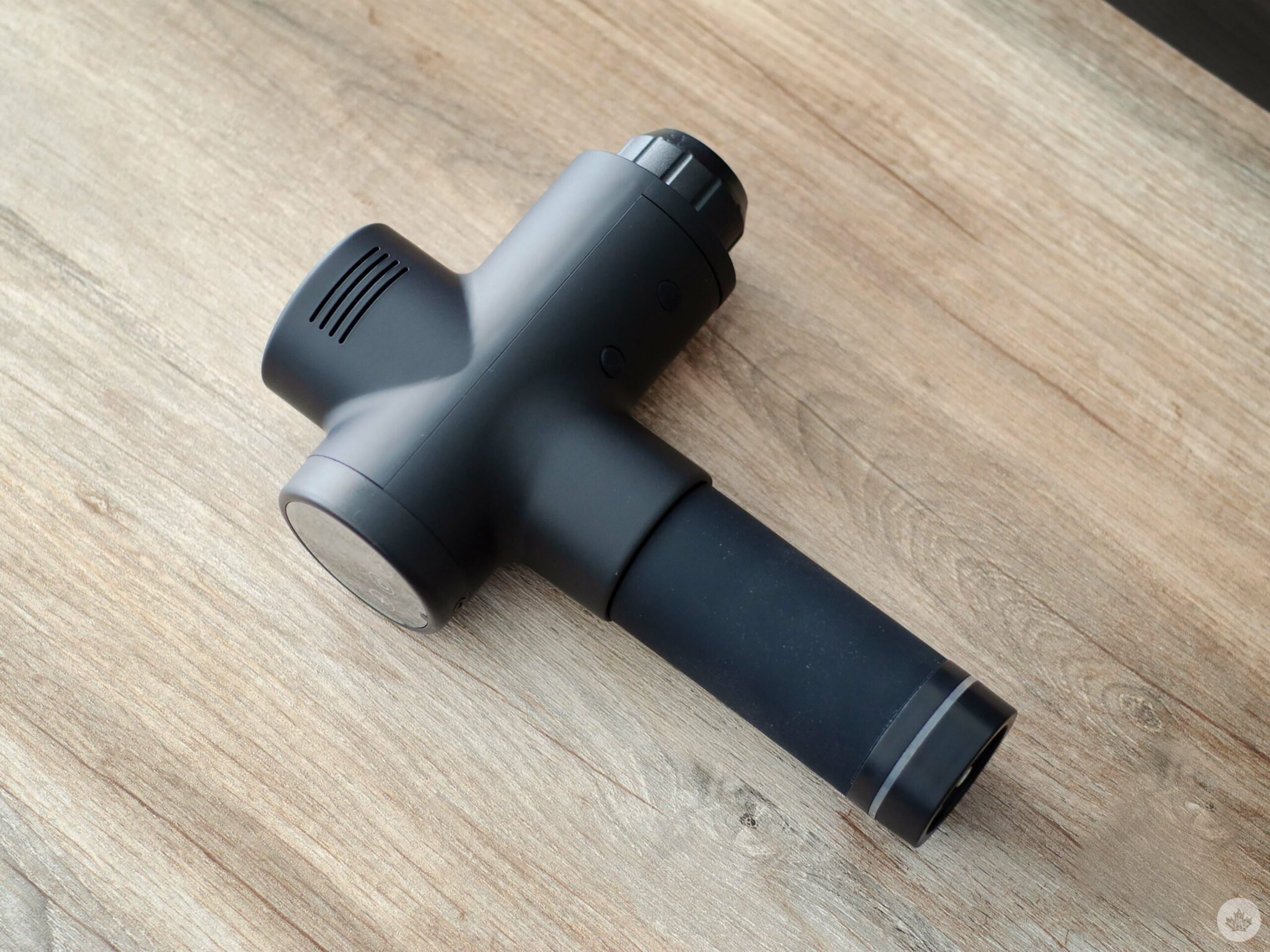 It’s tough to find much reliable information online about the EZ-X massage gun, unless you want to dig through the reviews on its Best Buy page. But luckily, Best Buy sent me a version to test for myself. And after two weeks of use and abuse, this robust device has held up surprisingly well.
It’s tough to find much reliable information online about the EZ-X massage gun, unless you want to dig through the reviews on its Best Buy page. But luckily, Best Buy sent me a version to test for myself. And after two weeks of use and abuse, this robust device has held up surprisingly well.
Construction-wise, EZ-X’s inspiration is right there on its sleeve. It’s heavily “influenced” by the Hypervolt’s design, right down to the motor’s ventilation ports. But holding the device reveals a stark difference. It’s light. And while that may be a plus for some owners, I prefer the heft of the heavier devices for digging into painful areas. Perhaps the best thing about the EZ-X is that its motor is whisper quiet—it might be the quietest massage gun I’ve tested.
The other main difference is the digital readout with its touchscreen buttons. Those non-buttons might help reduce the cost, but if I’m investing in a device, I’ll pony up for the tactile, percussive click of a real button any day. The controls let you climb through 30 speeds, though most of them are so closely spaced that it’s tough to tell them apart. The 2500mAh battery is also surprisingly good—I found that I didn’t need to charge it more than once a week with daily use.
Oh, and for the case-concerned, the EZ-X comes with a sturdy soft-shell case with useful nooks and crannies for its charger and six attachment heads. So far, it’s one of the best cases of any percussive massager I’ve tested.
All told, the EZ-X includes every bell and whistle you could hope for—and some extras no one will bother with. It’s hard to pick it apart, but only time will tell whether its construction holds up.
KiCA K2 Handheld Percussion Massage Device
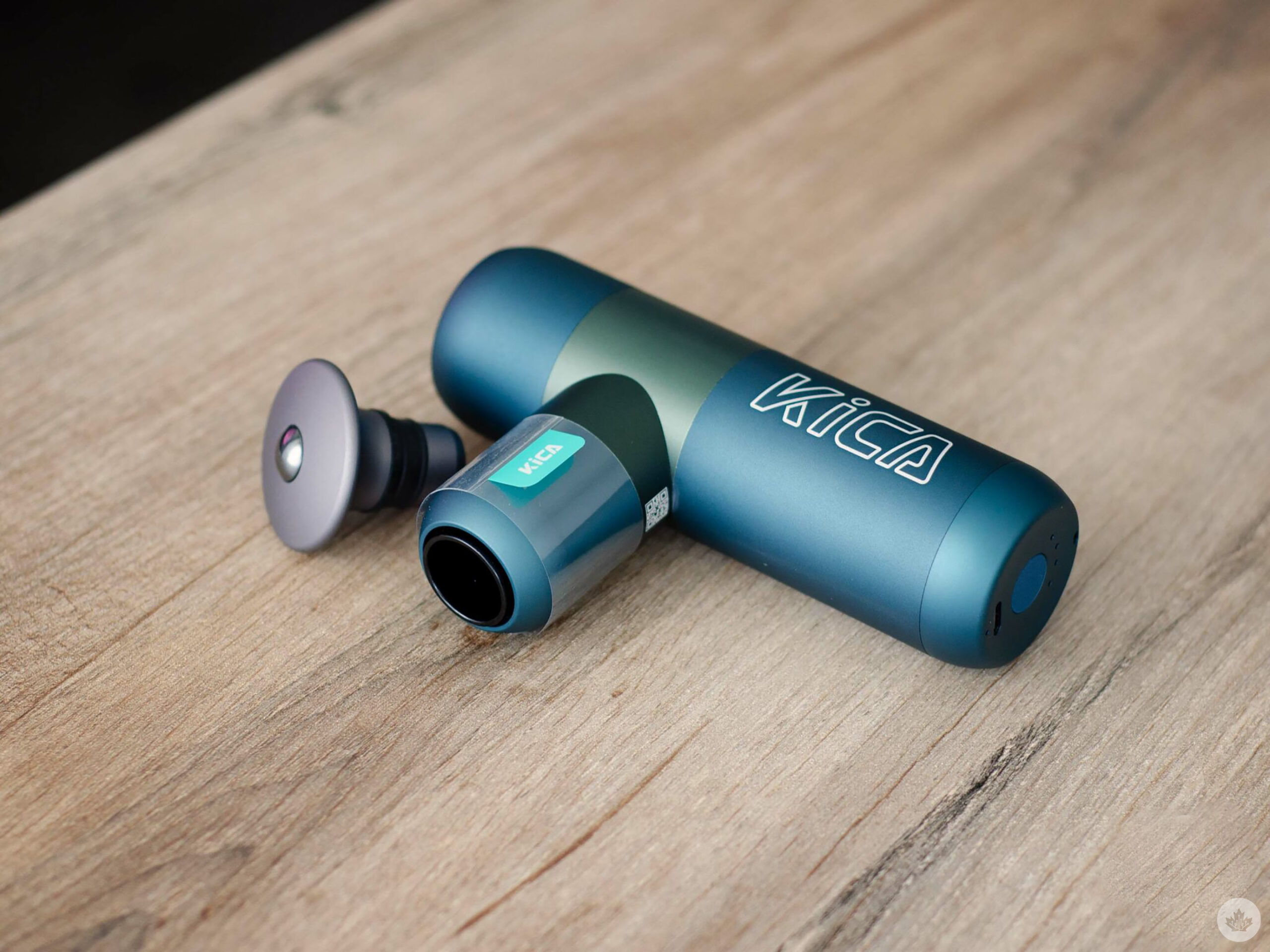 If portability and price are your main concerns—especially at the expense of power, the KiCA K2 percussive massager could be just the ticket. Its main body is a tad smaller than a can of red bull, and its right-angle protrusion doesn’t add much heft. It’s also fairly heavy for its size, but that’s a good thing. For such an inexpensive device, it feels well made, and it’s whisper-quiet, even at the highest of its four well-spaced speeds.
If portability and price are your main concerns—especially at the expense of power, the KiCA K2 percussive massager could be just the ticket. Its main body is a tad smaller than a can of red bull, and its right-angle protrusion doesn’t add much heft. It’s also fairly heavy for its size, but that’s a good thing. For such an inexpensive device, it feels well made, and it’s whisper-quiet, even at the highest of its four well-spaced speeds.
The lithium-ion battery is slated to last 18 hours on a 2.5-hour charge, and it features an auto-shutoff after 10 minutes, perhaps in case you fall asleep using it. Which could happen—it really is that quiet.
Where it falls short, though, is in its four included heads. The only two you’ll likely use are the foam ball and the plastic “pancake” head, but both are so grippy that they’re tough to move around on whatever muscle you’re working on. The ball head in particular has a very “styrofoam” feel. The device has a single physical button rather than the annoying touchscreen of the EZ-X, which is a plus, but the USB-C charger requires a standard USB outlet—there’s no included wall adapter.
One last gripe, and it’s the grip. Whereas every other device I tested featured a rubberized grip area, the KiCA’s is brushed metal. It’s not going to slip out of your hand, but it’s also not going to dampen vibrations during extended use.
So should you buy it? It’s a worthwhile investment if you just want something inexpensive that’s easy to travel with. But if you really like using it, you may find that you eventually crave something more powerful.
KiCA Mini
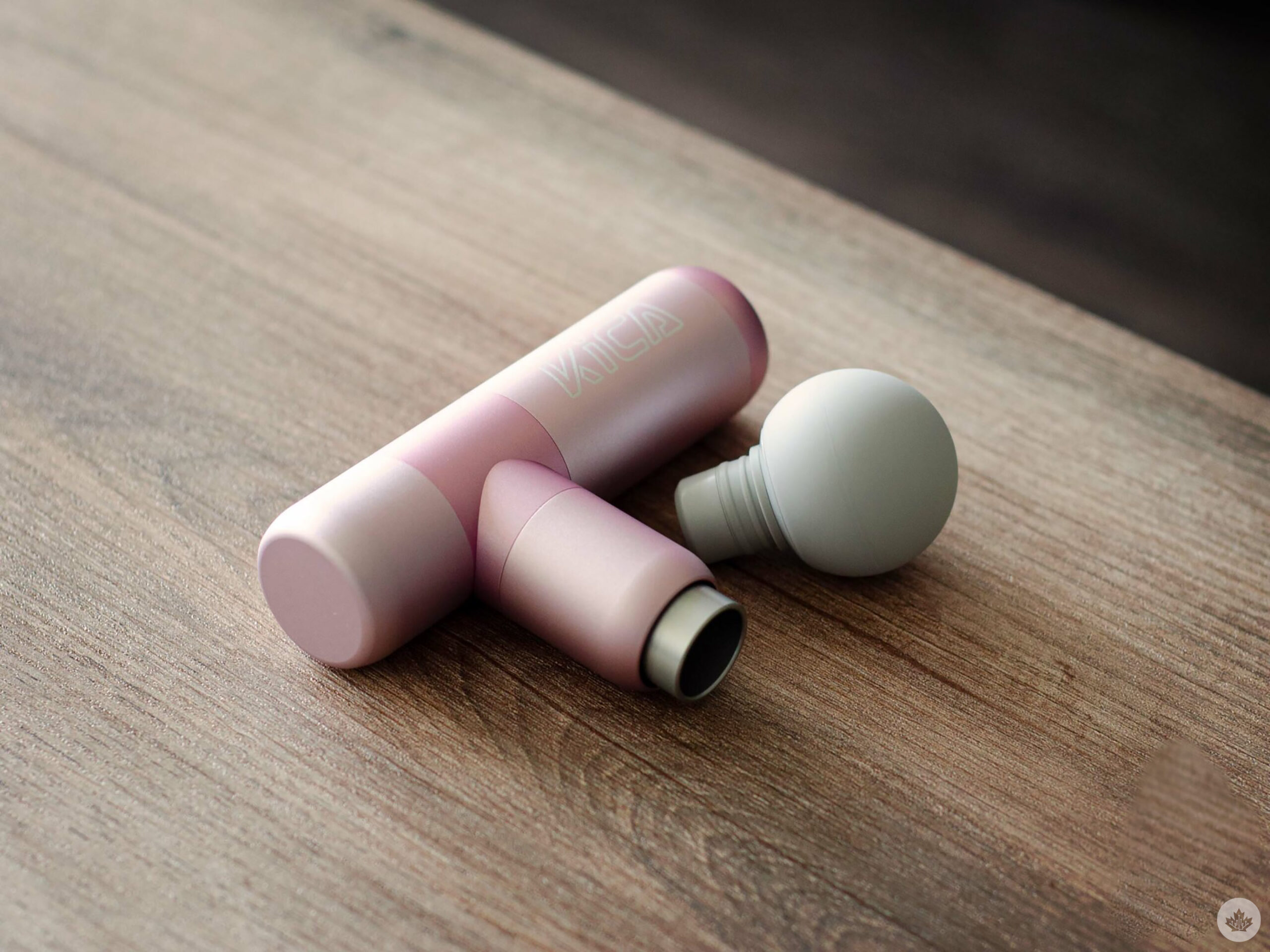 If the KiCA’s form factor resembles a Red Bull can, the KiCA Mini massage gun is closer to a roll of quarters. For slightly less money, you get one extra head (which manages to be even grippier than the others), a velvet bag instead of a hardshell case, and significantly less power. At the slowest two speeds of its four-speed spread, its motor stalled with even moderate pressure, and even the highest speed paled in comparison to its bigger, more powerful counterparts.
If the KiCA’s form factor resembles a Red Bull can, the KiCA Mini massage gun is closer to a roll of quarters. For slightly less money, you get one extra head (which manages to be even grippier than the others), a velvet bag instead of a hardshell case, and significantly less power. At the slowest two speeds of its four-speed spread, its motor stalled with even moderate pressure, and even the highest speed paled in comparison to its bigger, more powerful counterparts.
In all honesty, if extreme portability is your goal, go with the regular-size KiCA. The mini version simply sacrifices too much power for its compact form factor, and unless your goal is to increase blood flow with a mild tingling sensation, the other massage guns on this list will serve you much better.
Final verdict
If you’re willing to invest in a top-of-range device, you really can’t go wrong with the Hypervolt or Theragun pro. If you want something quiet and convenient, go with the Hypervolt. But if volume isn’t a concern and you can handle some therapeutic pain, the Theragun is more up your alley.
If you want portability, the Theragun Mini is a near-perfect device that won’t disappoint. And if you don’t want to overspend, the EZ-X massage gun has a lot of promise despite its lack of brand-name reputation and proven reliability. Of course, if you’re on a bare-bones budget and prefer something extremely portable, the KiCa K2 fills that bill.
MobileSyrup utilizes affiliate partnerships and publishes sponsored posts. These partnerships do not influence our editorial content, though MobileSyrup may earn a commission on purchases made via these links.
MobileSyrup may earn a commission from purchases made via our links, which helps fund the journalism we provide free on our website. These links do not influence our editorial content. Support us here.


